2008
Maryland, My Ever Tighter Maryland
No doubt about it: The ever-congested Maryland suburbs have been a boon for equestrian businesses. Nowhere else in the United States is there such a plethora of lesson, training and boarding stables–not to mention tack and feed stores. There is plenty of business for vets, farriers, farm sitters, equine massage therapists–you name it. Maryland’s per-mile density of equestrian offerings is unique.
The suburbs provide clients for the lesson and boarding stables. Inside the Baltimore-Washington corridor, there are thriving stables mere miles apart, offering plenty of options for the client. The more rural it gets, the more the number of lesson and boarding facilities start to dwindle due to less demand.
The suburban edges offer handy-dandy farmettes, three- and five-acre chunks of land in which adults can realize their childhood passions of “having a horse farm,” while providing a steady stream of business for local feed stores and tractor suppliers (not to mention a whole new market for tractor manufacturers). A savvy health care professional can spend all day traveling down one lane, going from “farmette” to “ranchette”–and never travel more than a few miles!
Be they boarders or “farmetters,” not only do these horse people fuel the Maryland equine economy, they are active participants in equestrian activities. These horse owners fill the membership rolls of the eventing, trail riding and foxhunting clubs and fill the entries at horse trials, hunter paces and other competitions.
But while good for horse businesses, the congested Maryland countryside has proven increasingly challenging for horse sports and no one knows this better than those men and women hunting hounds in Maryland today.
Many packs hunt a combination of farmland and parkland, but even those huntsmen fortunate enough to have a pack in areas with a good bit of open land have had to face the challenges of increasing traffic and landowners who are new to the traditions of the countryside.
The challenges of development and traffic affect everything the huntsman does, from his or her breeding preferences to pack training methods to how the hounds are actually hunting.
How DOES a huntsman deal with it?
James Faber – Marlborough Hunt, Upper Marlboro
(photo by Isabel Kurek)
 Huntsman Jim Faber is in his ninth season with the Marlborough pack. “He has a tremendous rapport with the hounds, an uncanny ability to know the direction a fox has taken and his care of our hunt country, fox population, hounds and kennels,” says jt.-MFH Katherine Cawood.
Huntsman Jim Faber is in his ninth season with the Marlborough pack. “He has a tremendous rapport with the hounds, an uncanny ability to know the direction a fox has taken and his care of our hunt country, fox population, hounds and kennels,” says jt.-MFH Katherine Cawood.
“Well, the land is fast evaporating. That’s quite a concern. But the country is lovely to hunt in, and the climate is lovely – it’s got good winters. It’s a lovely area to hunt in, provided we continue to have open space.
“That’s what drew me to Maryland, basically; the type of country that, on the East Coast, is getting harder and harder to find. We have some galloping country and certainly we have hills, which makes it more interesting in hunting hounds.
“Roads and traffic are a very large concern, and certainly make our hunting tougher, in how we hunt the country and where we go because of the roads and the density of the population.”
George Harne Jr. – New Market-Middletown Valley Hounds, Middletown
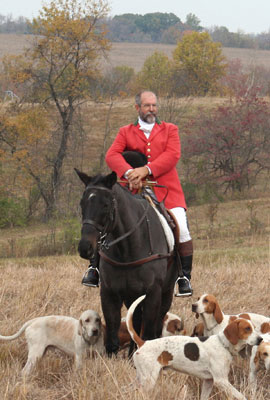 After working for the New Market-Middletown Valley Hounds for 10 years as a kennelman and a whip, George Harne Jr. graduated to hunting the pack five years ago.
After working for the New Market-Middletown Valley Hounds for 10 years as a kennelman and a whip, George Harne Jr. graduated to hunting the pack five years ago.
“ I just like the countryside, the terrain and stuff…the farms and the woods, the way it’s laid out.
“The big challenge to it is being able to hunt with all the development. Other that that, it’s pretty much just regular hunting, with some coops in the livestock area. But with the dairy farmers…going out of business, there’s less and less need for the coops.
“Radios for the staff and stuff – I don’t believe in them in our situation. Now, if I were chasing coyote and had major roads to contend with, I would want them. But for us, we don’t need them yet – and ditto for cell phones. I mean, some of the members and some of my staff do carry cell phones, in case they were to get hurt; but we don’t communicate on them at all. And as far as electronic collars go, I will use like a shock collar every now and then, for them running riot on deer and stuff. We do not use tracking collars, simply because of the expense–and we don’t need them at this point.”
Geoffrey Hyde – Elkridge-Harford Hunt, Monkton
(photo Karen Kandra Wenzel)
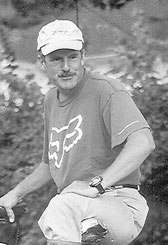 Geoffrey Hyde has been with the Elkridge-Harford pack for 19 seasons, 17 of them as its huntsman. “Geoff Hyde is passionate, hard working and a fantastic huntsman,” says jt.-MFH Liz McKnight.
Geoffrey Hyde has been with the Elkridge-Harford pack for 19 seasons, 17 of them as its huntsman. “Geoff Hyde is passionate, hard working and a fantastic huntsman,” says jt.-MFH Liz McKnight.
“We hunt a mixed country, with nice grass and woods and crops and corn fields. It’s varied, and there are a ton of foxes, with good coverts–including multiflora rose, which helps keep the coyotes at bay.
“We have the usual challenges, like the roads; somebody always has to be out on the road. Everyone is under a lot of pressure to develop in Maryland, and that pushes the edges [of our territory] a lot.”
Dulany Noble – Carrollton Hounds, Carroll County
 Dulany Noble is a jt.-MFH of the Carrollton Hounds, which hunts primarily in Carroll County. For the past six seasons, she has also carried the horn for this pack.
Dulany Noble is a jt.-MFH of the Carrollton Hounds, which hunts primarily in Carroll County. For the past six seasons, she has also carried the horn for this pack.
“Our territory is simply breathtaking. We hunt at the kindness of our generous landowners, most of whom are farmers. We hunt mostly gently rolling farmland and woods…not all the fixtures have jumps, but most have at least a few and some have lots. Our fences are all very inviting and usually not more than 3’ 3” to 3’ 6”.
“Our fixtures continue to shrink because of development, so we always have to be on the look out for new territories. We are most fortunate to have added two new territories this year. One other nuisance is that a lot of people who move to the country just do not understand what it is we do, so they can make it difficult in some areas.
“We use electronic aids very sparingly. We do not use walkie-talkies, but carry cell phones for safety’s sake. It is rarely that we have to use them. We use shock collars very sparingly and usually don’t have to use them more than twice for the hound to get the message.”
Robert Taylor – Goshen Hounds, Woodbine
(photo by Isabel Kurek)
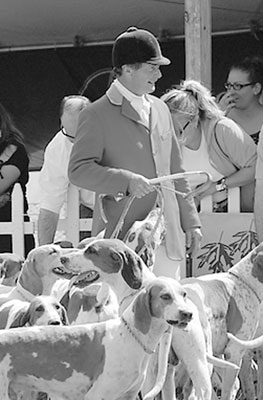 Robert Taylor has been providing Goshen foxchasers with sport for 14years. “I think his most outstanding trait as a huntsman is his very patient handling of young hounds,” says Jt.-MFH Tom Pardoe. “American hounds are not the easiest to handle. They often have rather delicate personalities that can be permanently damaged if not handled properly. They also seem often to mature more slowly than other hounds. When staff and masters grow impatient with a young hound, it is always Robert who insists ‘Let’s give him another season.’ So often he is right!”
Robert Taylor has been providing Goshen foxchasers with sport for 14years. “I think his most outstanding trait as a huntsman is his very patient handling of young hounds,” says Jt.-MFH Tom Pardoe. “American hounds are not the easiest to handle. They often have rather delicate personalities that can be permanently damaged if not handled properly. They also seem often to mature more slowly than other hounds. When staff and masters grow impatient with a young hound, it is always Robert who insists ‘Let’s give him another season.’ So often he is right!”
“I like the challenge that the topography presents each day…the fact that we have all these wonderful wooded areas and we have the Patuxent River…the challenges that that brings I enjoy, because you have to be right there to help [the hounds] and even to view them and listen to them; you have to be right on the ball, because you don’t have the big open spaces to cut across the field or whatever. That’s why I like the challenges.
“The challenges are the terrain itself and how uneven it is and how difficult it can be. We’re able to go wherever we have permission to go, but being actually able to get there – the topography is often as challenging for me as it is for the master and the field, you know, to keep up.”
Larry Pitts – Potomac Hunt, Boyds
(photo by Lanah Hamilton)
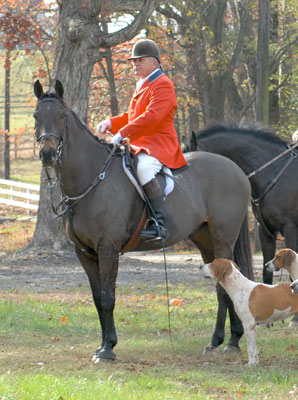 Larry Pitts has hunted the Potomac pack for 28 years. “He has an amazing amount of control, and we truly have a deer-proof pack,” says jt.-MFH Vicki Crawford. “Larry also is very patient when hounds are speaking/running, making sure that he knows where they are headed. Often, we are amazed when he just sits still, seeming to know which way the fox will run, and, all of a sudden, the fox turns and the hounds will head right back towards us!”
Larry Pitts has hunted the Potomac pack for 28 years. “He has an amazing amount of control, and we truly have a deer-proof pack,” says jt.-MFH Vicki Crawford. “Larry also is very patient when hounds are speaking/running, making sure that he knows where they are headed. Often, we are amazed when he just sits still, seeming to know which way the fox will run, and, all of a sudden, the fox turns and the hounds will head right back towards us!”
“We have some members that are really genuinely concerned about your well-being and the hounds’ well-being. They’ve been loyal to me, so I try to be loyal to them–so that’s the main reason [I like it here]. There are people in the club that I get along well with.
“Another reason is our hounds. I like our hounds, the Virginia variety of the American hounds, the Bywaters type.
“In our country, though, we have to worry about roads too much. You would be amazed; you’d think [development] would be worse, but that’s not our big problem…if we got along better with some old landowners that somebody way back when didn’t pay attention to, we’d be better off, too. People–not us–made trouble, and they won’t let any horsepeople ride [through].
“Also, our hounds are too much hound for most of our country! They really fly, and it’s hard to stay on them…every year or so, I say, ‘Are we going to slow ’em down? And they all look at each other and look back and say, ‘No, we like ’em the way they are!’ And I say, ‘That’s what I thought you’d say; I just wanted to make sure.’”
Bobby Reber – Reber Hounds, Kent County
(photo by Binnie Houghton)
 The Reber Hounds is a small, informal pack of Penn-Marydel foxhounds owned and hunted by Bobby Reber since the 1980s. Though kenneled in Pennsylvania, the pack hunts mostly in Maryland’s Kent County near the tributaries of the Chesapeake Bay. “Our main interest is in hound work rather than ‘a run and jump’ experience,” says Reber. Follower Edwin Fry agrees. “My favorite thing about Bobby Reber is his desire to have a pack with good nose, good voice, and the hunting skill to provide good sport,” he says.
The Reber Hounds is a small, informal pack of Penn-Marydel foxhounds owned and hunted by Bobby Reber since the 1980s. Though kenneled in Pennsylvania, the pack hunts mostly in Maryland’s Kent County near the tributaries of the Chesapeake Bay. “Our main interest is in hound work rather than ‘a run and jump’ experience,” says Reber. Follower Edwin Fry agrees. “My favorite thing about Bobby Reber is his desire to have a pack with good nose, good voice, and the hunting skill to provide good sport,” he says.
“The good foxes and landowners who have allowed us to be there with the hounds [are what I like most here]. The territory is unpaneled, but there is an abundance of good open fields and small thick coverts that usually allow foxes to give good sport without leaving the territory.
“The many ditches and swamps near the water make it a challenge to always stay close to hounds … especially if the fox decides to swim across one of the deeper waterways, leaving staff a long trip around. When the water freezes, it is a heart-stopping moment watching hounds pursue the scent across the ice!”
“In today’s world…such technology is needed to keep lines of communication open, to keep hounds safe, help staff stay with hounds and enable the field to be in a position to appreciate the sport. The electric collars can be very useful in training. A prime concern is being able to control hounds to keep the pack working together and protect them from the hazards of today’s many roads. All the hounds have the huntsman’s cell phone number on their collars. This has been very helpful in quickly locating lost hounds.”
Jane Rhoades – Wicomico Hunt, Eastern Shore
(photo by Sydney Dickson)
 After years of hunting her own pack elsewhere, Jane Rhoades became jt.-MFH and huntsman of Wicomico two years ago.
After years of hunting her own pack elsewhere, Jane Rhoades became jt.-MFH and huntsman of Wicomico two years ago.
“[This territory] was a big adjustment—it’s very flat and sandy, which seems to be a little easier on your horse than up and down the hills, but you don’t get those wonderful views.
“Wicomico hunts a lot in state land, and it’s very lovely to hunt in there, because you have a lot of privacy and there seem to be plenty of foxes about. The swamps are my biggest challenge; on the Eastern Shore of Maryland, we have a lot of big swamps, and [when] the hounds get in there, you are just waiting for them to return, and sometimes it’s a long wait. And sometimes you’ll want them to come out and you can’t get in to get them.
“We moved down here to get away from the encroachment of Chester County [Pennsylvania]; it got so populated. But I have noticed that the encroachment is coming on the Eastern Shore also, and it’s a challenge to find landowners who will let a large group of riders [come through].
“The deer laws are a challenge, also. There are so many deer laws and turkey and firearm laws, and you have to jiggle your schedule around quite a bit of that other activity. But everybody has to share.
“I used to be against [electronic aids], but I’m not anymore. I think the radios for your staff, your people who are helping and even car followers are essential because of all the new development and all the traffic. I never used them until the last couple of years, and they can be abused–and there are a lot of people who can’t hunt without a radio today, but I think for safety, because of the population, because of traffic, they’re almost essential. And I never thought I’d say that!
“Tracking collars I do not use; we do have them, but I have not used them. Now, I’m not saying I never will, but at this particular time, I do not use them. But we do use the radios; I have a radio, and the field master and the whipper-in. And if there’s somebody following in a pickup, we give them a radio–just so that there are no accidents, just in case. The field masters carry cell phones, because if someone gets injured or hurt, it’s very easy to call for help, and give location and so forth; but they’re not supposed to be conversing on them just because they want to talk about something, like they do in the grocery store.”
Adam Townsend – De La Brooke Foxhounds W, Leondardtown
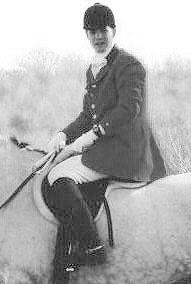 Having hunted the De La Brooke hounds for four years, Adam Townsend has gained a solid reputation among his followers. “He’s the hardest-working boy I’ve ever known,” says Field Secretary Sandy Sweikar. “Everything is so clean and well kept…and the hounds love him! He drives to the hound shows and brings home ribbons and trophies every time, and [his hunting] is excellent. We love him.”
Having hunted the De La Brooke hounds for four years, Adam Townsend has gained a solid reputation among his followers. “He’s the hardest-working boy I’ve ever known,” says Field Secretary Sandy Sweikar. “Everything is so clean and well kept…and the hounds love him! He drives to the hound shows and brings home ribbons and trophies every time, and [his hunting] is excellent. We love him.”
“Down here, we’re right on the rivers–the Potomac and the Wicomico, and the Chesapeake Bay–so we have a lot of wetlands, swamps that hold a tremendous amount of gray fox. That makes it good, because you can kind of go to a swamp and you’re pretty much promised three or four gray fox. It’s a really good haven for them.
“A lot of our [coverts] are basically covered by field on three sides, so it’s not like they’re back in the woods or extremely trappy. You can get around most of it. But sometimes swamps can be really good, and sometimes they can be a challenge, because if hounds run straight through a swamp and the fox exits on the other side, we have to go all the way around, you know, to stay with them.
“It’s really not too developed down here, so it’s just a lot of continuous open area – and we don’t have to deal with too many roads. We probably only have a couple of fixtures that are a little bit tighter with a little bit more congestion, but even here at the kennels, we can hunt as far as we can see.”
Many thanks to Laurel Scott, who provided these notes from interviews she conducted prior to leaving her position as Equiery editor for a position as senior editor with Source Interlink Media’s Equine Network, publishers of EQUUS, Practical Horseman, Horse & Rider, Dressage Today and other fine magazines. The Equine Network is based in Gaithersburg, Maryland.









